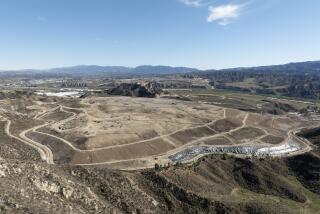Tennis Players Return to Courts After Landfill’s Leaky Gas Line Is Replaced
- Share via
Play resumed this week on tennis courts at the Scholl Canyon recreation complex in Glendale, following completion of a massive project to replace a faulty pipe system that had leaked noxious gas from the adjoining city landfill.
The tennis courts and an adjacent municipal golf course were shut down two years ago because of explosive levels of methane leaking from an inactive landfill beneath them. The city has since installed a new gas-collection system at a cost of about $750,000, said Kerry L. Morford, assistant public works director. The golf course remains closed for more work.
The 10 tennis courts, restrooms and a reservations office were reopened Monday by three partners--Michael Rinn, who supervises the city’s adult team-tennis program; his wife, Catherine; and businessman Sarkis Miridjanian. They will operate the facility under a one-year contract with the city.
The contract allows Rinn to operate the Scholl Canyon courts at 3800 E. Glenoaks Blvd., as well as four courts in Central Park at Louise and Colorado streets.
Rinn’s proposal, selected from among five submitted to the city, is expected to provide about $33,000 a year in revenue to the city, said Nello Iacono, director of parks, recreation and community services.
Iacono said closure of the Scholl Canyon courts two years ago caused severe overcrowding at the city’s 25 other courts. “Tennis is one of the more popular sports in our city,” said Iacono, who reported that a large number of players showed up on opening day Monday.
Rinn said the courts will be open from 8 a.m. to 10 p.m. daily for a fee of $2 an hour weekdays and $4.50 an hour evenings and weekends. The facility has new nets and lights and the courts have been refinished, Rinn said.
The Scholl Canyon tennis courts and adjoining golf course were closed in September, 1988, after officials found potentially explosive levels of methane building in electrical vaults and sewer manholes and leaking from earth fissures. Methane is given off by decomposing garbage.
The tennis courts are on solid ground next to the dump.
However, the nine-hole, 1,700-yard municipal golf course, built atop the landfill, had been plagued with problems since before it opened in 1981. The slopes of the course shifted by as much as 15 feet, wrecking landscaping and breaking sprinkler systems. Golfers nicknamed the facility “Stinky Canyon” because of the constant foul odor of methane that burned brown holes in the grass, killed trees and caused occasional small bursts of flame.
The new system uses flexible pipelines connected with seams that twist and bend with the constant movement in the landfill. Gas is collected in wells and pipelines and sucked to the adjacent active portion of the landfill where it is burned off in flares at a county Sanitations District facility.
Morford said the new system is four times more efficient than the old system, which was built in 1983 with rigid plastic pipes that clogged and broke.
City consultants said the movement and problems at Scholl are typical of landfills. However, the shifting has been particularly dramatic at Scholl because of the extreme depth of the canyon landfill--up to 245 feet in some areas, according to Mandeville and Associates of Pasadena.
Morford said the new system has eliminated the foul odors near the tennis courts and clubhouse, although he said the city will have to give the system constant maintenance. “We are extremely pleased with this new system. It is doing the job,” he said.
The city is adding a six-foot layer of dirt to the landfill to provide a base on which to restore the golf course. More than 5,000 truckloads of dirt are being hauled to the site from nearby private subdivisions at no cost to the city, Morford said.
The city expects that it will take at least two years to rebuild the golf course, Iacono said.
Meanwhile, the city is investigating ways to utilize the landfill’s methane. Morford said the city is considering building a plant to convert the gas into electricity, similar to a program it had several years ago that was shut down by the South Coast Air Quality Management District because of excessive toxic and smog-inducing emissions.
New technology could be used to build a plant without harmful emissions, he said.
The city is considering building a pipeline to carry the gas to the city’s power plant where it could be used instead of natural gas.
More to Read
Sign up for Essential California
The most important California stories and recommendations in your inbox every morning.
You may occasionally receive promotional content from the Los Angeles Times.










